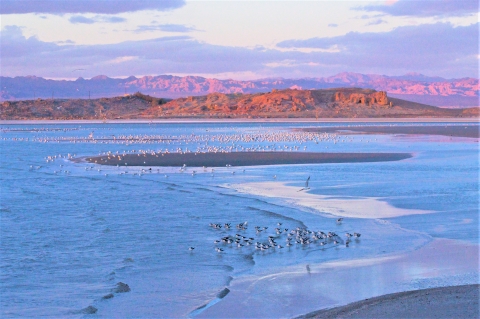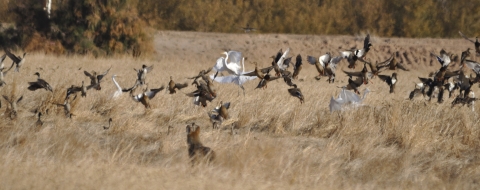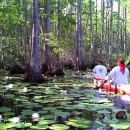Visit Us
The Sonny Bono Salton Sea National Wildlife Refuge provides numerous recreation opportunities to thousands of visitors every year. People enjoy viewing the unique geology and diverse wildlife. The regulation of recreational activities allows the public to enjoy the refuge while still protecting the wildlife and habitats. The majority of our accessible refuge wetlands lay in our Unit 1 management area (at the intersection of Bannister & Vendel Rd). Visitors to Unit 1 can walk our Hardenberger Trail, occupy our 2 photo blinds (both of which have been recently renovated), or use our observation tower and platform located next to the parking lot. Unit 1 also provides visitors with a small outhouse and a kiosk. Our Headquarters, Visitor Center, newly renovated flush bathrooms and water fountain, and a gift shop are located at 906 W Sinclair Rd. While here visitors can also access our Rockhill Trail, a 2-mile out-and-back trail.
Since its establishment, the refuge has had a fluid relationship with the shoreline and is not completely landlocked due to the shrinking of the sea. Though visitors can still take in sweeping views of the Sea and shoreline from our Rockhill trail which ends on top of our “active” volcano.
Visitor Center
Volunteers are available to provide you with maps, brochures, and checklists, and let you know what is happening on the refuge. The center is surrounded by agricultural fields, desert uplands, cattail marshes, the Salton Sea shoreline, a small active volcano, and freshwater wetland habitats. All habitats can be viewed by walking the Rockhill trail or walking up the observation tower next to the center. Inside the center, you will find a bird diorama and a bookstore run by Sea and Desert Interpretive Association.
Tips to Help You Enjoy Your Visit
- Bring water, sunscreen, hats, and appropriate clothing for weather conditions
- Bring binoculars, spotting scopes, and cameras to enhance your visit
- Go to https://ca.audubon.org/node/26691 for a map of all the interesting birding spots around the Salton Sea
- Visit the refuge with a friend to share the experience
- Contact the refuge for information and recent wildlife sightings
- Respect other refuge visitors’ viewing opportunities
- Minimize disturbance to wildlife
- Keeping noise levels to a minimum will enhance wildlife viewing
Location and Contact Information
About Us
Established in 1930 and dedicated to Congressman Sonny Bono for his massive conservation efforts at the Salton Sea in 1998, the refuge provides vital wetland and grassland habitat for a plethora of migratory birds along the Pacific flyway.
The refuge is separated into 2 different management units along the southern end of the sea. Each unit is composed of a mosaic of different habitats like cattail marshes, shorelines, open water wetlands, grass fields, and desert uplands that are maintained by the refuge staff to provide a sanctuary to over 100,000, birds, close to 40,000 of which are waterbirds, in a state that has lost 90-95% of its natural wetlands.
What We Do
The Sonny Bono Salton Sea National Wildlife Refuge was originally designed to reduce waterfowl depredation to adjacent croplands, and the refuge still fills that role today.
- Management practices include an intensive farming program that involves cooperative farmers.
- Crops like ryegrass and wheat are grown for waterfowl consumption during the fall/winter migration period.
Our Species
With 90-95% of California’s original wetlands gone, the Salton Sea has become one of the most important nesting sites and stopovers along the Pacific Flyway. Historically, as many as 95% of the North American population of eared grebes migrated through the Sea, along with 90% of American white pelicans, 50% of ruddy ducks, and 40% of Yuma Ridgeway's rails. With its highly saline, freshwater, desert, wetland, and agricultural habitats, the refuge provides a sanctuary for hundreds of birds and wetland species, including several that have been listed as endangered or sensitive by the U.S. Fish & Wildlife Service.






